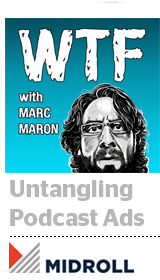 Podcast consumption swelled from 29 million monthly users in 2014 to 46 million in 2015, according to findings from an ongoing study by Edison Research and Triton Digital.
Podcast consumption swelled from 29 million monthly users in 2014 to 46 million in 2015, according to findings from an ongoing study by Edison Research and Triton Digital.
The popular podcast “WTF? With Marc Maron” is happily riding the wave.
“We’re benefiting from the shifting media landscape,” said the podcast’s producer, Brendan McDonald. “There is a lot of money coming in that used to be parked almost exclusively in terrestrial radio, and advertisers are very active in their pursuit of podcast real estate.”
“WTF?” has existed for nearly five and a half years. The bulk of the show’s ad business is direct response-based, though McDonald said the list of advertisers has diversified in the past year. The diversity of clients has grown commensurately with the growth of the podcast’s audience, he added. And the podcast is downloaded roughly 3,000 times an hour every day.
As an example of the changing advertiser mix, McDonald pointed to website services company Squarespace, which has ramped up podcast spend in recent years. A dedicated podcast advertiser, Squarespace increased its marketing budget to $40 million this year, according to GigaOm research released in February.
“What they spend on podcast marketing is competitive with any national company,” said McDonald. “They’re dumping a lot of money into podcasts. That’s part of their strategic vision. It’s great for them and it’s great for us.”
Formats for the show include pre-roll, post-roll and mid-roll spots. All advertising on the podcast is done though live reads by Maron, and each spot is positioned to organically mirror or complement the context of the show.
For example, creative content could be originated to match an episode’s theme.
When the podcast began, it had a number of revenue streams beyond advertising, like donations, merchandising and live shows. But today, more than 85% of its revenue comes from advertising.
Despite growing interest, podcast advertising is still faced with challenges, said McDonald. One of the biggest hurdles is measurement.
Unlike digital audio streaming, where advertisers have access to insights like location and demographic data in real time, there’s no such metric for podcasts. Though advertisers are privy to download volume and location, there’s no way to tell if a podcast was played to completion, therefore no way to confirm an ad was heard.
Without a way to gauge how long a listener played a podcast, or if the audience even reached the ad, advertisers are clamoring for new ways to measure audience engagement and activity.
“In order to remove friction, there needs to be better ways to measure the audience, to geotarget the audience and to measure the amount of time they’re listening,” said McDonald. “A big constraint is that we’re still not seeing a majority of people streaming the show. The majority of people are still downloading the show. A stream can be mined much more clearly for data than a download, which, once extracted, kills any further metric.”
“WTF?” sees a 60/40 split of downloads vs. streams.
The show’s ad business is handled exclusively by Midroll, a podcast ad network and original content studio that works with about 220 advertisers. It handles all inventory booking, pricing and client relations for “WTF?”
According to Midroll, podcast advertising can be incredibly lucrative for the more popular series. Chief Adam Sachs told Business Insider that a “handful” of the firm’s clients gross more than $1 million a year. Midroll takes 30% of those revenues.
The high returns are dude to podcasting’s high CMPs relative to other mediums.
“Over time, we’d love to be able to give clients an actual measurement of how many people heard the ad,” said Midroll EVP of sales and development Lex Friedman. “One other additional metric we’ll be able to provide soon is recall studies for advertisers. We’ll tack on a call to action at the end of the show to bring listeners to a survey, so we can get a better sense of who’s remembering what.”
As it stands, direct-response advertisers have more options to measure listeners, explained Friedman. They can attach an offer code or a vanity URL to podcasts to track the activity that results from a podcast ad.
Yet as advertising interest around podcasts increases, and budgets shift from terrestrial to digital, is there an opportunity for programmatic ad delivery to find its way to podcasting?
“Its definitely possible,” said Friedman. “There are folks in the space who are really working on dynamic ad insertion. I think that can get pretty programmatic.”
In order for programmatic podcast advertisings to become a reality, Friedman added that advertisers would have to do ad injection at the time of download, which would take into account geotargeting data and listener insights.
Unfortunately for “WTF? With Marc Maron,” that doesn’t hold any value for the time being.
“Right now, it does us no good to inject any type of advertising into the show that is not native or coming directly from our content creation, which is just Marc’s voice,” said McDonald. “Were we to have a better sense of the demographics and the geographics, it would make more sense to sell a more diversified ad unit.”












